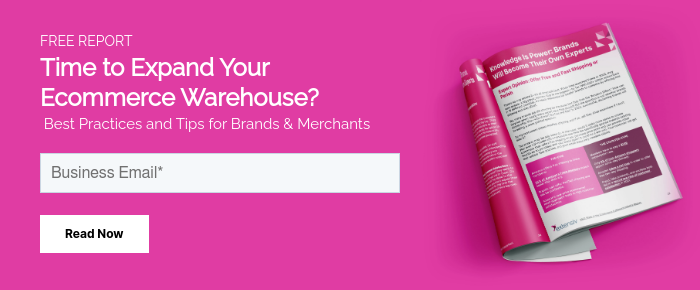The ecommerce industry is on fire right now and for brands looking to compete during the Black Friday/Cyber Monday push, optimizing your technology (aka tech) stack is one way to get ahead. The right tech stack can help brands with everything from automating time-consuming, mundane tasks to increasing profits and improving logistical efficiency.
A “tech stack” is just a fancy way of referring to a collection of software applications, integrations, and platforms brands can use to run their business efficiently and profitably. This collection includes things like inventory management systems (IMS), mobile barcode scanners, or adding technology to support more progressive sales solutions.
But even if you are interested in using a sophisticated, tailored technology stack to help your business keep up with the holiday season gift-giving bonanza, you might be unsure of where to direct your energies if you don't have the resources to do an exhaustive search.
To save you some time, we have combed through the possibilities out there to provide you with a list of common solutions for brands just starting to build out your tech stack and for brands interested in more advanced technology options.
Two Things to Do Before You Get Started
1. Assess Your Specific Needs and Current Resources
Before you explore new solutions, take a moment to verify that your business is already covering the basics. Do you have an effective system to collect online payments? Are you using sophisticated inventory management software that can take on more volume or keep track of returns?
Black Friday is the mirror you need to look at yourself and be honest about the resources you are working with and whether they align with your business goals. If you’re relying on color-coded 2007 Excel spreadsheets to track inventory or trying to deliver pre-built jungle gyms in a family sedan, there is a disconnect that needs to be remedied.
It’s imperative that you take a moment to figure out what your company needs and if you have the resources you need to meet them. For example, what products are you selling and through what channels? Do you sell big items or small ones? Are the products slow or fast moving? Do they require refrigeration? What happens if you’re relying on materials from China that could instantly dry up if more lockdowns are instituted?
The bottom line here is to be thoughtful and realistic before adding bells and whistles to your tech stack.
2. Ensure Your Future Goals Align with Your Needs
Opting for cheap or free options may sound good now, but when your business starts booming, will you be able to scale quickly and have the resources to manage a big change with minimal disruption? Try to keep this in mind as you evaluate your needs because if you’re just starting out, you aren’t always able to see far enough down the road. Saving a few dollars now could end up costing a fortune in the future.
Beyond financial considerations, it’s also wise to identify the tools/programs that work best at scale and which ones will support your business through its entire lifespan.
Basic Technology Solutions to Consider
Every business must start somewhere and brands in the early stage should ideally focus on building a solid foundation of tried-and-true technology solutions. After all, a violinist doesn’t start with selections from Paganini’s Caprices before learning “Twinkle, Twinkle Little Star.” So for brands focused on using software to create a solid infrastructure, here’s how to start laying the groundwork.
Sales Platform
Digitally-native brands by definition don't have a storefront, so your sales platform is everything. Shopify may be a great place to start since it allows brands to create and customize an online store and sell in multiple places. Volition, WooCommerce, and Wix are other options to consider.
Payments
Digital brands need a variety of ways to collect payments, manage subscriptions, sometimes features like Buy Now Pay Later (BNPL). Payments software allows for better revenue capture and provides brands with a turnkey solution to collect payments as they scale into new channels.
Customer Support
In the digital landscape, offering excellent customer service is not optional—it is necessary for your success. When building your customer support tech stack, consider offering self-service options for simple customer issues. You can also provide a knowledge base populated with FAQs that address common customer service issues. Ecommerce helpdesk solutions like Gorgias can help in this area.
Marketing Software
Ultimately brands need a way to engage with prospects and current customers to drive sales. Early on, brands can send emails to a customer list through Mailchimp or another basic email marketing software. Solutions like Klaviyo, an ecommerce marketing automation platform for email marketing and SMS, sync your technology with your website store and many offer good introductory offers for early-stage brands. Besides using such platforms, consider incorporating regular checkups and tracking your metrics and the email bounce rate with an efficient email finder tool.
Supply Chain/Logistics
Brands need a way to manage POs, inventory, order volume, and shipments—in a pinch, even basic software options like a small parcel solution, a warehouse management system (WMS), order management system (OMS), or inventory management system (IMS) can do the trick. Managing supply chain and logistics provides a clear picture of where your products are so you're not operating in the dark.
Robust Technology Solutions to Consider
Your business is booming, customers are happy, and you’re making an impact on the industry—why change anything? Your strategies are what got you to this point after all. But just because it’s worked so far doesn’t mean it will work in the future. A growing ecommerce business needs a tech stack that grows with them, not one that is still celebrating the glory days. So if you’re ready to build a more advanced tech stack, here are some options to explore.
Sales Platform
When a more robust platform is needed to launch new SKUs faster and support custom bundles, new UI, and cart recovery, brands may want to consider moving from basic Shopify to Shopify Plus in order to gain more customizable and open-source features. BigCommerce is also an excellent ecommerce platform; its advanced product search engine is ideal for larger brands.
Payments
Larger brands need more than basic payment solutions at this stage. Stripe offers more refined features to manage payments for your customers, suppliers, and vendors. It also offers one centralized area where you can manage payments, pending payments, chargebacks, etc. for all your channels, providing you with greater flexibility whether you're selling online or in person.
Customer Support
If your customer support strategies don’t address factors like return rates and increases in service requests during the Black Friday rush, these failures can impact sales for the remainder of the year and beyond. This might be the time to invest in programs like Gorgias, Zendesk, or ReplyDesk, which offer integrations within your current software, as well as the platforms themselves. Even more advanced brands might want to invest in a CRM that allows them to manage all client communications and interactions in one spot, combining support and outreach.
Marketing Software
When brands get to a more advanced stage, one option is to invest in an omnichannel marketing solution like Postscript so you can plan out campaigns, target specific segments of customers, and sequence multi-pronged marketing efforts. Heymarket can help you reach customers on multiple channels from a single shared inbox and saves time with features like personalized text messaging and conversational context to trigger responses and automate workflows.
Supply Chain/Logistics
As brands mature, they need more robust functionality than what is provided through entry-level small parcel solutions. Consider the scalability and connected nature of your WMS and OMS to ensure they can continue to grow with you. Large brands often invest in enterprise resource planning (ERP) to manage all their resourcing, but ERPs can be rigid.
Consider building a connected software system so different departments can tailor the software for their use and still function within a harmonized system. The modules used in connected software systems (e.g., WMS, OMS, etc.) offer a seamless experience through connectivity, visibility, and adaptability. Brands may also want to consider employing a Transportation Management System (TMS) to better manage their freight shipments as they traverse the globe.
A Note on Automation ...
Finding ways to automate tasks and processes through ecommerce automation software can help you convert manual tasks into self-fulfilling automated tasks, cutting down the need for constant oversight. Here's how Extensiv's technology platform can help:
Since many brands are already using smartphones and tablets to manage their inventory levels, a WMS, like Extensiv Warehouse Manager, offers options to print product barcodes and scan bins and SKUs from your mobile device so you can manage your fulfillment on the go, wherever you are in the warehouse. Extensiv Warehouse Manager also issues automated alerts when stock is running low.
Extensiv Integration Manager ensures that orders are standardized and directed to your fulfillment centers and management systems. When orders are placed, inventory levels are synchronized and updated throughout the ecosystem. Extensiv Integration Manager also offers the option of automating certain tasks through Application Programming Interfaces (APIs) by facilitating connections between software applications. You can see all of our ecommerce, EDI retail partners, warehouse, and 3PL integrations here.
Extensiv Order Manager is a software solution that tracks inventory levels, customer orders, sales, and fulfillment automatically so you can focus on more pressing or high-level concerns. It includes features like order orchestration, automated replenishment, and the ability to auto generate purchase orders. It also offers insight into your inventory lead times, sell through, and current stock and tells you when you need to order inventory so you can make sure you have what your customers want.
Conclusion
No matter how large or small your business, there are countless options to explore—these are just a start. Many of them are easy to implement so you don’t need an entire IT department and a PhD in computer science to get them up and running. It’s not too late to optimize your tech stack for the holiday rush and adding just a few of these solutions can help you navigate this busy season by arming you with technology solutions that pay huge dividends.
___________________________________________________________________________
Download our white paper, Why Connected Commerce Will End the Reign of ERP, to see how connected commerce software can increase your revenue, integrate management systems, and provide access to real-time business metrics and KPIs.
To learn more about how an WMS or OMS can provide greater inventory control, request a demo.








